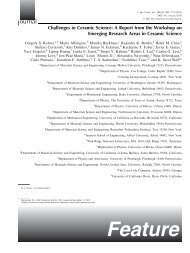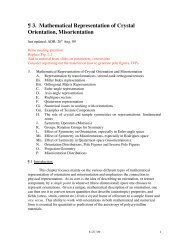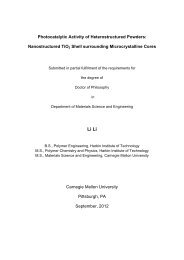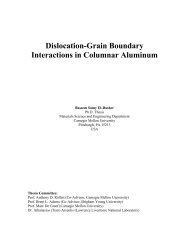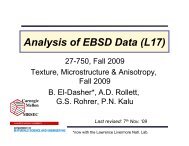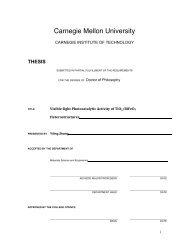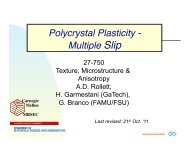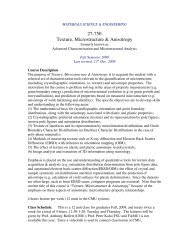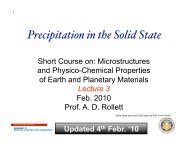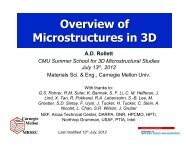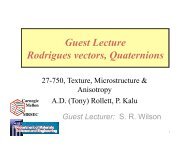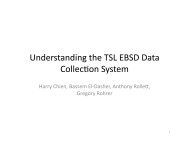A.D. Rollett, Carnegie Mellon Univ.
A.D. Rollett, Carnegie Mellon Univ.
A.D. Rollett, Carnegie Mellon Univ.
You also want an ePaper? Increase the reach of your titles
YUMPU automatically turns print PDFs into web optimized ePapers that Google loves.
1<br />
<strong>Carnegie</strong><br />
<strong>Mellon</strong><br />
MRSEC<br />
A.D. <strong>Rollett</strong>, <strong>Carnegie</strong> <strong>Mellon</strong> <strong>Univ</strong>.<br />
Last revised: 10 th Oct. ‘11
2<br />
• The objective of this lecture is to introduce<br />
students to the preferred orientation package<br />
from Los Alamos (popLA) so that they can<br />
analyze pole figure data, produce an<br />
orientation distribution and calculate basic<br />
properties.<br />
• Some familiarity with pole figures and<br />
orientation distributions is assumed.
3<br />
1. What is a standard sequence of operations to obtain an<br />
Orientation Distribution (OD) from a set of experimentally<br />
measured pole figures?<br />
2. What is the most important check on the quality of the OD<br />
calculation?<br />
3. How do you detect problems with defocussing, and what<br />
practical steps can you take to correct them?<br />
4. Why is the alignment of the specimen in an x-ray goniometer<br />
important for subsequent texture analysis?<br />
5. Why is it helpful to rotate (in-plane) pole figures before<br />
analysis?<br />
6. What properties can you calculate with popLA? (This is not<br />
covered in this lecture – you need to explore the package!).
4<br />
• popLA, at the moment, is a DOS-based package.<br />
(Work is in progress to write a new GUI for XP.) The<br />
basic sequence of steps to use the program for<br />
analyzing a pole figure data set are as follows.<br />
– Process the raw PF data (subtract background, apply defocussing<br />
correction, normalize)<br />
– Use the series expansion method (fitting of generalized<br />
spherical harmonics) to preform a preliminary OD analysis of<br />
the data<br />
– Use the re-normalized result from above as input to a WIMV<br />
analysis (calculation of a discrete OD)<br />
– Plot the results<br />
– Calculate volume fractions of texture components of interest<br />
– Calculate inverse pole figures, non-measured pole figures<br />
– Calculate sets of individual orientations weighted by their fit to<br />
the OD
POPLA<br />
Preferred Orientation Package-Los Alamos<br />
A.D. (Tony) <strong>Rollett</strong><br />
with thanks to Carl Necker, Los Alamos<br />
National Laboratory, and Raul Bolmaro,<br />
Rosario <strong>Univ</strong>., Argentina<br />
adapted from ICOTOM 15 Workshop, 2008
Preferred Orientation Package Los Alamos
C:/x/popla.bat<br />
1980s to Present: DOS based coherent set of programs<br />
works on many PC systems (started on IBM 286 DOS machine)<br />
Microsoft’s advent of Windows XP and Vista<br />
finding some issues, particularly with DOS screen capture<br />
Non-Windows based format not as user friendly to the Windows based world<br />
LANL contract with <strong>Univ</strong>ersity of Rosario, Rosario Argentina<br />
create a Windows based interface to run popLA<br />
user friendly interface<br />
remove programs that were driven by ‘slow’ computer speeds<br />
improve functionality
Historical information<br />
Things to keep in mind before using PopLA<br />
Review classic PopLA with typical data processing scenario<br />
Introduce the New and Improved PopLA<br />
A look under the hood – how the critical programs work<br />
Supplementary tools to be used in concert with PopLA<br />
What can you do to help improve PopLA?
(IBM 286!)<br />
Los Alamos thinking….<br />
+<br />
Automate the process of<br />
evaluating and presenting<br />
texture
Fred Kocks John Kallend Tony <strong>Rollett</strong><br />
Gilles Canova<br />
Rudy Wenk<br />
Raul Bolmaro<br />
Carl Necker<br />
Carlos Tome<br />
Tayfur Ozturk<br />
Stuart Wright
Time stamp on many of the critical programs: 1988-1989<br />
Kocks, Canova, Tome, <strong>Rollett</strong>, Wright, Computer Code LA-<br />
CC-88-6<br />
(Los Alamos, NM: Los Alamos National Laboratory, 1988)<br />
Kocks, Kallend, Wenk, <strong>Rollett</strong>, Wright, Computer Code LA-<br />
CC-89-18<br />
(Los Alamos, NM: Los Alamos National Laboratory, 1989)<br />
Minor changes through the early 1990s<br />
Otherwise: unchanged
typical 5-axis goniometer<br />
Bragg’s Law<br />
Proper goniometer alignment required!<br />
Keep peaks from shifting!<br />
PopLA is only as good as your measurements! (Garbage in, garbage out)
• Defocusing correction more important with decreasing 2θ and narrower<br />
receiving slit.<br />
• Best procedure involves measuring the intensity from a reference<br />
sample with random texture.<br />
• If such a reference sample is not available, one may have to correct the<br />
available defocusing curves in order to optimize the correction.<br />
• An important point to be aware of is that the exact shape of each<br />
defocussing curve depends on the material and the machine. The<br />
material influence is primarily through the diffraction angles (correction<br />
is more important for small angles). The machine influence is primarily<br />
through the slit widths (acceptance angle at the detector, e.g.).
1=RD Mark samples with orientations<br />
Record connection between<br />
sample nomenclature and<br />
orientation with goniometer<br />
reference frame.<br />
3=ND 2=TD<br />
popLA assumes a counter-clockwise data<br />
sequence in files thus UNRAW inverts the<br />
spin (RAW-EPF) since ‘our’ goniometer<br />
spins clockwise. Check the sense of rotation<br />
on your own system!<br />
Keeping track of these orientations is critical when dealing<br />
with non-symmetric textures as well as when you write your own<br />
programs to convert goniometer specific data into popLA format.
16<br />
How can you tell that the instrument<br />
and material (sample) axes are not<br />
aligned? Generally the pole figures<br />
tell you immediately, especially if any<br />
plane rolling has occurred during the<br />
lifetime of the material.<br />
It can easily happen that the<br />
sample is mounted in the<br />
instrument (x-ray<br />
goniometer, for example) in<br />
such a way that the natural<br />
material axes are not aligned<br />
with the instrument axes.
17<br />
Caution: if the mis-match between Materials and<br />
Instrument axes is more complicated than just in the<br />
X-Y plane, you will have to first compute the OD, then<br />
re-calculate complete pole figures, then you can use<br />
the popLA tool that permits out-of-plane rotations<br />
(page 2, #5). Alternatively, you can generate a<br />
Weighted List of orientations and rotate all the<br />
rotations in that list. This tool does not exist in popLA<br />
at this point so you will have to write your own<br />
program.<br />
So, what can you/ should you do<br />
about this issue?<br />
Answer: if you expect the texture to<br />
reveal the inherent material axes<br />
(that are a consequence of its<br />
thermomechanical history), then<br />
make the measurement and perform<br />
the rotations on the pole figures (in<br />
the X-Y plane: page 2, #4).
IT MUST BE PERFECT!<br />
First line is (a26) to include an 8 character name (a limitation) and date?<br />
Second line:<br />
Fortran (a5,4f5.1,5i2,2i5,2a5)<br />
(hkl,DR,RM,DAZ,AZM,IW,JW,IPER,IAVG,IBG,stuff)<br />
Third line+:<br />
(1x,18i4) if i>9999 then all data in the pole figure is scaled – IAVG
19<br />
popLA: preferred orientation package - Los Alamos (Page 1)<br />
U.F. Kocks, J.S. Kallend, H.R. Wenk, A.D. <strong>Rollett</strong>, S.I. Wright (April 1995)<br />
0. QUIT<br />
1. Get specimen DIRECTORY and VIEW a file<br />
2. MASSAGE data files: correct,rotate,tilt,symmetrize,smooth,compare<br />
3. WIMV: make spec.SOD; calculate PFs and inverse PFs; make matrices<br />
4. HARMONIC analysis: COMPLETE rim (.FUL), get Roe Coeff.file (.HCF)<br />
5. CONVERSIONS, permutations, transformations, paring<br />
6. DISPLAYS and plots<br />
7. Derive PROPERTIES from .SOD or .HCF files, make WEIGHTS file for simul.<br />
8. DOS (temporary: type EXIT to return)_<br />
Please type a number from 0 to 8 -->
20<br />
DISPLAYS AND PLOTS (popLA page 6)<br />
0. Quit<br />
1. Return to Page 1<br />
------ POLAR REPRESENTATION (Wenk and Kocks) ---------<br />
DENSITY PLOTS:<br />
2. POD: colors or gray-shades on VGA<br />
(with possibility to capture into .PCX file or such)<br />
or (with less resolution) direct to hp-LASERJET or PS-file<br />
CONTOUR PLOTS:<br />
3. OD sections from density files (Wenk program): very slow!<br />
4. single PF from density file (Wenk program, slow)<br />
5. single PF from density file (Kallend program, need PP.EXE or hp-plotter)<br />
DISCRETE ORIENTATION PLOTS:<br />
6. PFs, points or contours (Tome/Wenk program)<br />
7. DIORPLOT: all OD sections and projections, compatible with POD<br />
------ SQUARE SECTIONS (Kallend): cub/hex/tetr.cry.,ort/mono samples<br />
8. Colors on screen (fast, but limited options).<br />
9. Contours on hp-Laserjet (needs PP.EXE) or hp-plotter<br />
Please type a number from 0 to 9 -->
21<br />
POD
22<br />
popLA: preferred orientation package - Los Alamos (Page 1)<br />
U.F. Kocks, J.S. Kallend, H.R. Wenk, A.D. <strong>Rollett</strong>, S.I. Wright (April 1995)<br />
0. QUIT<br />
1. Get specimen DIRECTORY and VIEW a file<br />
2. MASSAGE data files: correct,rotate,tilt,symmetrize,smooth,compare<br />
3. WIMV: make spec.SOD; calculate PFs and inverse PFs; make matrices<br />
4. HARMONIC analysis: COMPLETE rim (.FUL), get Roe Coeff.file (.HCF)<br />
5. CONVERSIONS, permutations, transformations, paring<br />
6. DISPLAYS and plots<br />
7. Derive PROPERTIES from .SOD or .HCF files, make WEIGHTS file for simul.<br />
8. DOS (temporary: type EXIT to return)_<br />
Please type a number from 0 to 8 -->
23<br />
UNRAW<br />
MASSAGE DATA FILES (mostly PFs) (popLA page 2)<br />
0. Quit<br />
1. Return to Page 1<br />
2. Make THEORETICAL defocussing & background file: .DFB (R. Bolmaro)<br />
3. DIGEST Raw Data (.RAW), with exper.or theor. .DFB: make .EPF<br />
4. ROTATE PFs or adjust for grid offsets: make .RPF or .JWC<br />
5. TILT PFs around right axis: make .TPF (T. Ozturk)<br />
6. SYMMETRIZE PFs: make .QPF or .SPF or .FPF<br />
7. EXPAND PFs back to full circle (needed for WIMV & harm.): .FPF<br />
8. SMOOTH PFs or ODs with Gaussian Filter (quad, semi, or full): make .MPF<br />
9. Take DIFFERENCE between 2 files (PFs or ODs): make .DIF
24<br />
UNRAW<br />
DEMO RAW 17,447 10-0-93 8 ¦ Volume in drive C has no label<br />
olume<br />
Directory of C:\x\demo16FB ¦ :50a DEMO.RAW<br />
1 file(s) 17,447 bytes<br />
0 dir(s) 2,147,155,968 bytes free<br />
Note: If your data are on a SCINTAG .RR file: use DA5READ to make .RAW<br />
If they are on a PHILIPS .RAW file, use UNPHIL to make our .RAW<br />
If they are on an Aachen pole figure file, use AC2LA to make .EPF<br />
If they are on a RIGAKU .PFG file: use RIG2LA to make our .RAW<br />
(but you must have a PWD subdirectory into which it puts it:<br />
compliments of RIGAKU/USA.)<br />
(BREAK now to do any of the above..., else RETURN)<br />
Press any key to continue . . .<br />
Empirical Defocussing Correction<br />
Note: the sample is assumed to have rotated counter-clockwise<br />
Data will be sequenced clockwise in .EPF<br />
Enter name of raw data file (ext .RAW assumed) demo<br />
Enter name of correction file (ext .DFB assumed)demo
25<br />
demo Cu rol.90%,pt.reXeX (from Necker'<br />
(hkl)=(111) Background= 195 Using correction curve 1<br />
...correcting raw data<br />
...extrapolating outer ring<br />
...normalizing. Normalization factor= .088<br />
...writing corrected data to demo .EPF<br />
demo Cu rol.90%,pt.reXeX (from Necker'<br />
(hkl)=(200) Background= 248 Using correction curve 2<br />
...correcting raw data<br />
...extrapolating outer ring<br />
WARNING! Extrapolation gives negative intensities. Values set to 1<br />
...normalizing. Normalization factor= .134<br />
...writing corrected data to demo .EPF<br />
demo Cu rol.90%,pt.reXeX (from Necker'<br />
(hkl)=(220) Background= 433 Using correction curve 3<br />
...correcting raw data<br />
...extrapolating outer ring<br />
...normalizing. Normalization factor= .167<br />
...writing corrected data to demo .EPF<br />
Stop - Program terminated.<br />
Press any key to continue . . .
26<br />
popLA: preferred orientation package - Los Alamos (Page 1)<br />
U.F. Kocks, J.S. Kallend, H.R. Wenk, A.D. <strong>Rollett</strong>, S.I. Wright (April 1995)<br />
0. QUIT<br />
1. Get specimen DIRECTORY and VIEW a file<br />
2. MASSAGE data files: correct,rotate,tilt,symmetrize,smooth,compare<br />
3. WIMV: make spec.SOD; calculate PFs and inverse PFs; make matrices<br />
4. HARMONIC analysis: COMPLETE rim (.FUL), get Roe Coeff.file (.HCF)<br />
5. CONVERSIONS, permutations, transformations, paring<br />
6. DISPLAYS and plots<br />
7. Derive PROPERTIES from .SOD or .HCF files, make WEIGHTS file for simul.<br />
8. DOS (temporary: type EXIT to return)_<br />
Please type a number from 0 to 8 -->
27<br />
DISPLAYS AND PLOTS (popLA page 6)<br />
0. Quit<br />
1. Return to Page 1<br />
------ POLAR REPRESENTATION (Wenk and Kocks) ---------<br />
DENSITY PLOTS:<br />
2. POD: colors or gray-shades on VGA<br />
(with possibility to capture into .PCX file or such)<br />
or (with less resolution) direct to hp-LASERJET or PS-file<br />
CONTOUR PLOTS:<br />
3. OD sections from density files (Wenk program): very slow!<br />
4. single PF from density file (Wenk program, slow)<br />
5. single PF from density file (Kallend program, need PP.EXE or hp-plotter)<br />
DISCRETE ORIENTATION PLOTS:<br />
6. PFs, points or contours (Tome/Wenk program)<br />
7. DIORPLOT: all OD sections and projections, compatible with POD<br />
------ SQUARE SECTIONS (Kallend): cub/hex/tetr.cry.,ort/mono samples<br />
8. Colors on screen (fast, but limited options).<br />
9. Contours on hp-Laserjet (needs PP.EXE) or hp-plotter<br />
Please type a number from 0 to 9 -->
28<br />
quadrants or (circles): 1,2,3-6,7-12 1-2,3-11 (8)<br />
semi-circles: : 1,2,3-12 1-2,3-11<br />
Enter the number of plots on page ( 3<br />
Enter name of data file # 1 --> demo.epf<br />
Scanning data set identified by:<br />
demo Cu rol.90%,pt.reX DFB=demo<br />
(111)<br />
0 to start with this data set<br />
n to skip n data sets --> 0<br />
Scanning data set identified by:<br />
demo Cu rol.90%,pt.reX DFB=demo<br />
(200)<br />
Scanning data set identified by:<br />
demo Cu rol.90%,pt.reX DFB=demo<br />
(220)<br />
Absolute MAXIMUM of all plots in file = 1299.<br />
Absolute MINIMUM of all plots in file = 0.<br />
Now you will determine the intensity scale to be used,<br />
on the basis of 8 major contours.<br />
(Some choices will later put 2 intervals each.)<br />
Choose highest contour value <br />
--> 0
29<br />
demo Cu rol.90%,pt.reX DFB=demo<br />
(220)<br />
Absolute MAXIMUM of all plots in file = 1299.<br />
Absolute MINIMUM of all plots in file = 0.<br />
Now you will determine the intensity scale to be used,<br />
on the basis of 8 major contours.<br />
(Some choices will later put 2 intervals each.)<br />
Choose highest contour value <br />
--> 800<br />
-- How many major contours below intensity 1.0 ?<br />
<br />
--> 1<br />
MAJOR CONTOURS will be at (times random):<br />
8.00<br />
5.66<br />
4.00<br />
2.83<br />
2.00<br />
1.41<br />
1.00<br />
.71<br />
HIGH resolution. Contours: Y<br />
0: OK; 1: try again --> 0
30<br />
Plot with GMT:<br />
Plot with popLA:
31<br />
popLA: preferred orientation package - Los Alamos (Page 1)<br />
U.F. Kocks, J.S. Kallend, H.R. Wenk, A.D. <strong>Rollett</strong>, S.I. Wright (April 1995)<br />
0. QUIT<br />
1. Get specimen DIRECTORY and VIEW a file<br />
2. MASSAGE data files: correct,rotate,tilt,symmetrize,smooth,compare<br />
3. WIMV: make spec.SOD; calculate PFs and inverse PFs; make matrices<br />
4. HARMONIC analysis: COMPLETE rim (.FUL), get Roe Coeff.file (.HCF)<br />
5. CONVERSIONS, permutations, transformations, paring<br />
6. DISPLAYS and plots<br />
7. Derive PROPERTIES from .SOD or .HCF files, make WEIGHTS file for simul.<br />
8. DOS (temporary: type EXIT to return)_<br />
Please type a number from 0 to 8 -->
32<br />
ROTATE<br />
MASSAGE DATA FILES (mostly PFs) (popLA page 2)<br />
0. Quit<br />
1. Return to Page 1<br />
2. Make THEORETICAL defocussing & background file: .DFB (R. Bolmaro)<br />
3. DIGEST Raw Data (.RAW), with exper.or theor. .DFB: make .EPF<br />
4. ROTATE PFs or adjust for grid offsets: make .RPF or .JWC<br />
5. TILT PFs around right axis: make .TPF (T. Ozturk)<br />
6. SYMMETRIZE PFs: make .QPF or .SPF or .FPF<br />
7. EXPAND PFs back to full circle (needed for WIMV & harm.): .FPF<br />
8. SMOOTH PFs or ODs with Gaussian Filter (quad, semi, or full): make .MPF<br />
9. Take DIFFERENCE between 2 files (PFs or ODs): make .DIF
33<br />
Directory of C:\x\demo16FB ¦ :59a DEMO.EPF<br />
1 file(s) 17,607 bytes<br />
0 dir(s) 2,147,155,968 bytes free<br />
ROTATE POLE FIGURES AND/OR CHANGE GRID<br />
Program by John Kallend<br />
1. Symmetry analysis and rotation about center<br />
2. Change grid azimuth offset (JW)<br />
3. Change grid polar and azimuth offset (IW,JW)<br />
4. Invert spin<br />
Enter 1, 2, 3, or 4 --> 1<br />
Input file (with .ext, default .EPF): demo<br />
111 demo Cu rol.90%,pt.reX DFB=demo<br />
200 demo Cu rol.90%,pt.reX DFB=demo<br />
220 demo Cu rol.90%,pt.reX DFB=demo<br />
SUGGESTED ROTATION 1.8 DEGREES<br />
Is this ok? Y<br />
ROTATE
34<br />
This step required to bring material axes in line with<br />
Instrument axes, as discussed previously.<br />
1.8 degrees
35<br />
HARMONIC ANALYSIS (popLA page 4)<br />
0. Quit<br />
1. Return to Page 1<br />
Find harmonic coefficients .HCF, completed PFs (.FUL) for:<br />
2. Cubic crystal system<br />
3. Hexagonal, tetragonal or orthorhombic crystal system<br />
4. Compute SOD or COD from harmonic coefficients (slow!)<br />
5. Recalculate pole figures .HPF<br />
6. Inverse pole figures .HIP<br />
7. List harmonic coefficients to screen or printer<br />
Note: To convert Aachen-format Bunge coeffs. to Kallend's binary<br />
Roe coeff.file .HCF: use AC2Wlmn (outside this menu) -<br />
Also need FAKTOR.CtW (J. Hirsch)<br />
8. Establish coefficients for a given TRANSFORMATION<br />
9. Apply TRANSFORMATION to given coefficients<br />
Please type a number from 0 to 9 -->
36<br />
Harmonic Pole Figure Analysis (Cubic)<br />
Enter name of data file (default .epf): demo<br />
1demo Cu rol.90%,pt.reX<br />
3 Pole figures read in.<br />
How many iterations on missing parts? 9<br />
CUBIC ODF ANALYSIS FOR demo<br />
Sample symmetry:<br />
0. Orthorhombic<br />
1. Mirror perpendicular to Z<br />
Enter 0 or 1==> 0<br />
Error output to:<br />
1. printer<br />
2. screen<br />
Enter 1 or 2 ==> 2<br />
CUBAN2
37<br />
200 Reflection. Trunc. error = .36 Normalization = .10E+01<br />
220 Reflection. Trunc. error = .39 Normalization = .10E+01<br />
Severity = 1.712. Generated to l = 22<br />
ERROR ESTIMATES: 1. Polefigures<br />
L MEAN 111 200 220<br />
0 .228E-06 .225E-06 .233E-06 .225E-06<br />
2 .204E-02 .155E-02 .247E-02 .198E-02<br />
4 .245E-02 .255E-02 .301E-02 .155E-02<br />
6 .146E-02 .201E-02 .114E-02 .101E-02<br />
8 .162E-02 .111E-02 .149E-02 .210E-02<br />
10 .127E-02 .113E-02 .716E-03 .174E-02<br />
12 .622E-03 .869E-03 .181E-03 .610E-03<br />
14 .124E-02 .120E-02 .111E-02 .139E-02<br />
16 .706E-03 .145E-03 .539E-03 .109E-02<br />
18 .545E-03 .786E-03 .306E-03 .424E-03<br />
20 .572E-03 .556E-03 .355E-03 .740E-03<br />
22 .764E-03 .665E-04 .591E-03 .118E-02<br />
ALL .113E+00 .106E+00 .103E+00 .127E+00<br />
2. Estimated avg. error in ODF .38<br />
RE-ESTIMATING MISSING PARTS OF POLEFIGURES<br />
Writing harmonic coefficients to demo .HCF<br />
Print out Wlmn coefficients ? Y
38<br />
Plot with GMT:<br />
Plot with popLA:
39<br />
popLA: preferred orientation package - Los Alamos (Page 1)<br />
U.F. Kocks, J.S. Kallend, H.R. Wenk, A.D. <strong>Rollett</strong>, S.I. Wright (April 1995)<br />
0. QUIT<br />
1. Get specimen DIRECTORY and VIEW a file<br />
2. MASSAGE data files: correct,rotate,tilt,symmetrize,smooth,compare<br />
3. WIMV: make spec.SOD; calculate PFs and inverse PFs; make matrices<br />
4. HARMONIC analysis: COMPLETE rim (.FUL), get Roe Coeff.file (.HCF)<br />
5. CONVERSIONS, permutations, transformations, paring<br />
6. DISPLAYS and plots<br />
7. Derive PROPERTIES from .SOD or .HCF files, make WEIGHTS file for simul.<br />
8. DOS (temporary: type EXIT to return)_<br />
Please type a number from 0 to 8 -->
40<br />
The 3<br />
WIMV<br />
options<br />
WIMV Analysis (popLA page 3)<br />
0. Quit<br />
1. Return to Page 1<br />
WIMV: make .SOD and recalc. pole figures .WPF -- for:<br />
2. cubic, tetra-,hexagonal crystals; sample diad: up to 3 PFs, 13 poles WIMV<br />
3. trigonal cry.,gen'l.sample sym.,or higher: up to 7 PFs, 25 poles BWIMV<br />
4. orthorhombic crystals; sample Z-diad: up to 7 PFs, 25 poles OWIMV or WIMV386<br />
**or: orthorh./gen'l./7/25 **requires 386, DOS 5, and 4MB memory**<br />
Recalculate POLE FIGURES (even non-measured ones): make .APF -<br />
5. using .WIM matrix for the desired PFs (up to 3, 13 poles) SOD2PF<br />
6. using .BWM or .WM3 matrix for the desired PFs (up to 7, 25 poles)<br />
7. Calculate INVERSE pole figures from .SOD: .WIP<br />
OSOD2PF<br />
(So far assumes tetragonal crystal symmetry)<br />
SOD2INV<br />
8. Make WIMV pointer matrix for new crystal structure and set of PFs **<br />
9. Make WIMV pointer matrix for any INVERSE pole figures: make .WMI<br />
Please type a number from 0 to 9 --> INVGEN<br />
**WIMVGEN/BWIMVGEN/WGEN386; see later slides for notes on pointer matrices
42<br />
Note: the “FON” is<br />
the name for the<br />
uniform (“random”)<br />
background level;<br />
“raising the FON”<br />
means that the<br />
program will try to<br />
maximize this<br />
level. In practice,<br />
this makes little<br />
difference to the<br />
outcome.<br />
ODF ANALYSIS - WIMV ALGORITHM<br />
COPYRIGHT (C) 1987,1988 JOHN S. KALLEND<br />
*** Version September 1993 ***<br />
Enter the name of the wimv matrix (?.WIM)<br />
[Default is CUBIC] ==>CUBIC<br />
Name of data file (default extension .epf): demo.ful<br />
Sample Symmetry is:<br />
0. Orthorhombic<br />
1. Diad on Z<br />
Enter 0 or 1 ==> 0<br />
demo Cu rol.90%,pt.reX<br />
111 5.0 90.0 5.0360.0 1 1 2-1 3 100 72<br />
200 5.0 90.0 5.0360.0 1 1 2-1 3 100 72<br />
220 5.0 90.0 5.0360.0 1 1 2-1 3 100 72<br />
The minimum pole figure intensity is .01<br />
Do you wish to raise the Fon? N
43<br />
Iteration 2 in progress<br />
Sharpening may cause larger error in iteration 3<br />
Texture Strength (m.r.d.): 2.0<br />
(= square-root of "Texture Index")<br />
Iteration 2 estimated OD error (%) = 36.1<br />
Iteration 3 in progress<br />
Texture Strength (m.r.d.): 2.1<br />
Iteration 3 estimated OD error (%) = 30.5<br />
Iteration 4 in progress<br />
Texture Strength (m.r.d.): 2.2<br />
Iteration 4 estimated OD error (%) = 13.2<br />
Iteration 5 in progress<br />
Texture Strength (m.r.d.): 2.2<br />
Iteration 5 estimated OD error (%) = 10.4<br />
Iteration 6 in progress<br />
Texture Strength (m.r.d.): 2.2<br />
Iteration 6 estimated OD error (%) = 8.5<br />
Continue? Y
44<br />
Continue? Y<br />
Iteration 35 in progress<br />
Texture Strength (m.r.d.): 2.5<br />
Iteration 35 estimated OD error (%) = 1.8<br />
Continue? Y<br />
Iteration 36 in progress<br />
Texture Strength (m.r.d.): 2.5<br />
Iteration 36 estimated OD error (%) = 1.7<br />
Continue? Y<br />
Iteration 37 in progress<br />
Texture Strength (m.r.d.): 2.5<br />
Iteration 37 estimated OD error (%) = 1.7<br />
Continue? n<br />
Normalization factor: .99<br />
In output file, angles increase from 0 in nomenclature of<br />
1. Kocks (need this one for WEIGHTS)<br />
2. Roe/Matthies<br />
3. Bunge (rotates plot +90 deg.)<br />
Enter 1,2, or 3 ==> 1
45<br />
There are 3 “flavors” of the WIMV algorithm. Each successive<br />
version was developed to have more capability but the older<br />
versions were kept because they required less memory and ran<br />
faster (no longer an issue). We recommend that you always use<br />
the 3 rd option (menu item 4) which is the most capable. The<br />
executable is called OWIMV.EXE or, possibly,<br />
WIMV386.EXE, depending on your system.<br />
In order to use WIMV, one must have a “pointer matrix” which<br />
is just a list of which cells in pole figure space are connected to<br />
which cells in orientation space. Just as there are 3 versions of<br />
WIMV itself, so too there are 3 versions of the pointer<br />
generation program. WIMVGEN goes with WIMV.EXE;<br />
BWIMVGEN goes with BWIMV.EXE; WGEN386 goes with<br />
OWIMV (or WIMV386).
46<br />
To run the pointer matrix generation programs, you need to<br />
know the crystal symmetry (cubic, hexagonal, trigonal …), and<br />
any relevant ratios of lattice parameters (e.g. c/a for hcp), and<br />
which pole figures you want to be able to analyze. The<br />
program will guide you through how to enter the Miller indices<br />
for each pole figure (and it has certain preferences as to how to<br />
enter those values, e.g. 1 1 0, not 2 2 0).
48<br />
QUAD4<br />
MASSAGE DATA FILES (mostly PFs) (popLA page 2)<br />
0. Quit<br />
1. Return to Page 1<br />
2. Make THEORETICAL defocussing & background file: .DFB (R. Bolmaro)<br />
3. DIGEST Raw Data (.RAW), with exper.or theor. .DFB: make .EPF<br />
4. ROTATE PFs or adjust for grid offsets: make .RPF or .JWC<br />
5. TILT PFs around right axis: make .TPF (T. Ozturk)<br />
6. SYMMETRIZE PFs: make .QPF or .SPF or .FPF<br />
7. EXPAND PFs back to full circle (needed for WIMV & harm.): .FPF<br />
8. SMOOTH PFs or ODs with Gaussian Filter (quad, semi, or full): make .MPF<br />
9. Take DIFFERENCE between 2 files (PFs or ODs): make .DIF
49<br />
DEMO QPF 4,890 10-0-93 11 ¦ Volume in drive C has no label<br />
olume<br />
Directory of C:\x\demo16FB ¦ :32a DEMO.QPF<br />
1 file(s) 4,890 bytes<br />
0 dir(s) 2,147,155,968 bytes free<br />
File not found<br />
Directory of C:\x\demo16FB ¦ Volume in drive C has no label<br />
olume<br />
2,147,155,968 bytes free<br />
Make full pole figure from quadrant or semi<br />
Program by John Kallend<br />
Enter name of data file (with extension) : demo.wpf
50<br />
Plot with GMT:<br />
Plot with popLA:
51<br />
********************************************************<br />
To return to program, type EXIT (from SAME subdirectory)<br />
********************************************************<br />
Microsoft(R) Windows 98<br />
(C)Copyright Microsoft Corp 1981-1999.<br />
C:\x\demo>copy demo.ful+demo.fpf demo.cmb
54<br />
quadrants or (circles): 1,2,3-6,7-12 1-2,3-11 (8)<br />
semi-circles: : 1,2,3-12 1-2,3-11<br />
SOD2INV<br />
Enter the number of plots on page ( 3<br />
Enter name of data file # 1 --> demo.wip<br />
Scanning data set identified by:<br />
demo Cu rol.90%,pt.reXcalculated from SOD 8-OCT-93 strength= .00<br />
SOP3 PROJ<br />
0 to start with this data set<br />
n to skip n data sets --> 0<br />
Scanning data set identified by:<br />
demo Cu rol.90%,pt.reXcalculated from SOD 8-OCT-93 strength= .00<br />
SOP2 PROJ<br />
Scanning data set identified by:<br />
demo Cu rol.90%,pt.reXcalculated from SOD 8-OCT-93 strength= .00<br />
SOP1 PROJ<br />
THE FILE CONSISTS OF SOD SECTIONS:<br />
0 Plot default (full or quarter circles)<br />
1 Plot cubic inverse pole figures<br />
2 Plot tetragonal inverse pole figures<br />
3 Plot hexagonal inverse pole figures<br />
4 Plot trigonal inverse pole figures<br />
1
55<br />
Plot with GMT:<br />
Plot with popLA:
56<br />
popLA: preferred orientation package - Los Alamos (Page 1)<br />
U.F. Kocks, J.S. Kallend, H.R. Wenk, A.D. <strong>Rollett</strong>, S.I. Wright (April 1995)<br />
0. QUIT<br />
1. Get specimen DIRECTORY and VIEW a file<br />
2. MASSAGE data files: correct,rotate,tilt,symmetrize,smooth,compare<br />
3. WIMV: make spec.SOD; calculate PFs and inverse PFs; make matrices<br />
4. HARMONIC analysis: COMPLETE rim (.FUL), get Roe Coeff.file (.HCF)<br />
5. CONVERSIONS, permutations, transformations, paring<br />
6. DISPLAYS and plots<br />
7. Derive PROPERTIES from .SOD or .HCF files, make WEIGHTS file for simul.<br />
8. DOS (temporary: type EXIT to return)_<br />
Please type a number from 0 to 8 -->
57<br />
CONVERSIONS of SODs, HCFs, and discrete angles files (popLA page 5)<br />
0. QUIT<br />
1. RETURN to Page 1<br />
--- ORIENTATION DENSITY FILES ---<br />
2. Permute axes in .SOD<br />
3. Make .COD from .SOD file (or .CHD from .SHD)<br />
4. Make OBLIQUE sections from .SOD file: .SON,.CON, or .SHN,.CHN from .SHD<br />
(Note: no projections; use the one from end of .COD or .SOD)<br />
5. Pare to SUBSET for display: make .SOS or .COS (or .SHS,.CHS)<br />
--- DISCRETE ORIENTATION FILES ---<br />
6. Convert generic MILLER INDICES to any Euler angles<br />
7. DIOR: Add crystal and sample symmetries, permute axes, change<br />
angle convention, or make DENSITY file from DISCRETE grain file<br />
SOD2COD<br />
PARE
58 demo Cu rol.90%,pt.reX 37 WIMV iter: 1.7%,Fon= 0 2<br />
SODK Psi= 90.0<br />
Scanning data set identified by:<br />
demo Cu rol.90%,pt.reX 37 WIMV iter: 1.7%,Fon= 0 2<br />
SOP3 Psi=PROJ<br />
THE FILE CONSISTS OF SOD SECTIONS:<br />
0 Plot default (full or quarter circles)<br />
1 Plot cubic inverse pole figures<br />
2 Plot tetragonal inverse pole figures<br />
3 Plot hexagonal inverse pole figures<br />
4 Plot trigonal inverse pole figures<br />
0<br />
Absolute MAXIMUM of all plots in file = 8358.<br />
Absolute MINIMUM of all plots in file = 0.<br />
Now you will determine the intensity scale to be used,<br />
on the basis of 8 major contours.<br />
(Some choices will later put 2 intervals each.)<br />
Choose highest contour value <br />
--> 1600<br />
-- How many major contours below intensity 1.0 ?<br />
<br />
--> 2
61<br />
The conventional plotting approach is to use Cartesian (square) plots,<br />
as you find in most papers and books.<br />
We illustrate plotting using the programs smoothsod[.f90] (for<br />
smoothing orientation distributions with a Gaussian filter, and<br />
sodcon[.f] for contour plotting. The latter has options to plot with<br />
line contours, or solid colour. It can also plot ODs for hexagonal<br />
materials where one generally wants to limit the third angle to the<br />
range 0-60° because of crystal symmetry. These are available in<br />
texture_subroutines on my website. The latter program must be<br />
compiled with the package of routines called psplot.txt, which you<br />
can find at www.nova.edu/ocean/psplot.html .<br />
To compile fortran programs, try using gfortran on Macs<br />
(hpc.sourceforge.net) or g95 on PCs (www.g95.org).
62<br />
unsmoothed Smoothed (5°)
63<br />
unsmoothed Smoothed (5°)
64<br />
See neon.materials.cmu.edu/texture_subroutines for programs<br />
x = φ 1 , y = Φ , z = φ 2<br />
Use SOD2vtk.f to get a VTK file<br />
for 3D viewing
65<br />
PROPERTIES (popLA page 7)<br />
0. Quit<br />
1. Return to Page 1<br />
2. Assign WEIGHTS to discrete grains file from .SOD<br />
_ (Need Kocks style Euler angles in both .SOD and TEXfile -<br />
_ can convert the latter in DIOR, p.5,#7)<br />
3. Average ELASTIC properties (Reuss, Voigt, Hill, self-consistent)<br />
(Program by C. Tome) Input ELTEX.DAT, ELMOD.DAT; out ELOUT?.DAT<br />
4. SIMULATION of polycrystal PLASTICITY from weighted grains file -<br />
LApp code: with rate sensitivity and grain shape effects,<br />
for all crystal and sample symmetries (not much twinning):<br />
calculate current yield surface, Lankford coefficients;<br />
predict texture development, Taylor factors,<br />
stress/strain curves for all straining paths. Up to 1152 grains.<br />
SHEET properties directly from harmonic coefficients (Kallend)<br />
(only for orthotropic plane strain, cubic metals):<br />
LANK<br />
5. Yield locus section (11,22) for any angle in plane (Bishop-Hill)<br />
6. Lankford coefficients (Hosford-Backofen model)<br />
Please type a number from 0 to 6 -->
66<br />
Plastic anisotropy calculations for FCC, BCC metals<br />
from harmonic coefficients.<br />
Program by John Kallend (C)1969<br />
What is the specimen name (.HCF Assumed)? demo<br />
Plasticity data for demo Cu rol.90%,pt.reX<br />
RESTRICTED (R) or PENCIL (P) glide ?<br />
Enter P or R: ==> r<br />
Parameters calculated:<br />
M = Taylor Factor<br />
R = Lankford parameter<br />
qmin = width/length strain<br />
beta = ratio of plane strain strengths Mez=o/Mey=o<br />
Restricted glide<br />
Angle M R qmin Beta<br />
0 3.16 .87 .46 1.00<br />
15 3.13 .82 .45 .99<br />
30 3.10 1.19 .54 1.02<br />
45 3.04 1.62 .62 1.03<br />
60 2.99 1.31 .57 1.03<br />
75 3.01 .89 .47 .99<br />
90 3.05 .82 .45 .96<br />
Press any key to continue . . .
67<br />
PROPERTIES (popLA page 7)<br />
0. Quit<br />
1. Return to Page 1<br />
WEIGHTS<br />
2. Assign WEIGHTS to discrete grains file from .SOD<br />
_ (Need Kocks style Euler angles in both .SOD and TEXfile -<br />
_ can convert the latter in DIOR, p.5,#7)<br />
3. Average ELASTIC properties (Reuss, Voigt, Hill, self-consistent)<br />
(Program by C. Tome) Input ELTEX.DAT, ELMOD.DAT; out ELOUT?.DAT<br />
4. SIMULATION of polycrystal PLASTICITY from weighted grains file -<br />
LApp code: with rate sensitivity and grain shape effects,<br />
for all crystal and sample symmetries (not much twinning):<br />
calculate current yield surface, Lankford coefficients;<br />
predict texture development, Taylor factors,<br />
stress/strain curves for all straining paths. Up to 1152 grains.<br />
SHEET properties directly from harmonic coefficients (Kallend)<br />
(only for orthotropic plane strain, cubic metals):<br />
5. Yield locus section (11,22) for any angle in plane (Bishop-Hill)<br />
6. Lankford coefficients (Hosford-Backofen model)<br />
Please type a number from 0 to 6 -->
68<br />
Directory of C:\x\demo16FB ¦ Volume in drive C has no label<br />
olume<br />
2,147,155,968 bytes free<br />
*******************************************************************<br />
For discrete grains files, use the following (in c:\x):<br />
filename min.cry.sym min.sam.sym use #grains:<br />
-------- ----------- ----------- -----------<br />
texRAN any any any(1000)<br />
texRAN.WTS tetragonal Z-diad all(1000)<br />
texISO.wts tetragonal any/Z-diad/ortho. 1024/512/256<br />
texCUB.wts cubic any/Z-diad/ortho. 3072/1536/768<br />
...here, average triplets, so final # is 1024/512/256<br />
texREG.wts tetragonal diad on Z or Y 3456 (/3=1152 for cubic)<br />
orthotropic 1728 (/3=576 for cubic)<br />
fiber which stays 192 (/3=64 for cubic)<br />
*******************************************************************<br />
Intensity file (w/ext:.SOP or .S?D, default=.SOD): demo.sod
69<br />
Discard grains below a certain weight? Which? 0.<br />
.1<br />
texran :use any portion (only file when less than tetr.cry.sym.)<br />
Evm F11 F12 F13 F21 F22 F23 F31 F32 F33<br />
0.000 1.000 0.000 0.000 0.000 1.000 0.000 0.000 0.000 1.000<br />
Kocks:Psi Theta phi weight (up to 6 state parameters, f8.2) XYZ= 1 2<br />
Is this a file of triplets to be averaged? 0<br />
How many orientations total? 1500<br />
Do you wish to bring grains from outside the irreducible area<br />
into it, by applying 360/PHImax-fold crystal Z-axis?<br />
(Use 0 with TEXLAT.WTS, TEXISO.WTS, TEXCUB.WTS)-> 1<br />
Writing file<br />
demo .wts<br />
681 grains written<br />
Volume fraction .01 discarded<br />
You may wish to rerun with different limit on weights...<br />
For grain-shape effect, you must manually adjust F in .WTS file!<br />
(Also, you may wish to record vol.fraction discarded in 1st line.)
70<br />
• A frequent problem with using popLA for the first time concerns the main<br />
graphics program, POD. This program expects to see a file called<br />
PODIN. This file merely serves to record what parameters were used<br />
the last time that POD was run.<br />
• The file is available from <strong>Rollett</strong>’s popLA page:<br />
neon.materials.cmu.edu/rollett/popLA<br />
• Even if you have the file present in your \X directory, you will still need to<br />
copy it into whatever directory you are working in<br />
(copy C:\X\PODIN .).<br />
• Note that the main issue with POD under XP is that “PrintScreen” no<br />
longer works. An alternative approach to graphics is to use postscriptbased<br />
graphics. Programs (scripts) exist to plot pole figure information<br />
with GMT [Generic Mapping Tools, http://gmt.soest.hawaii.edu/ ]. The<br />
script is called “Draw_Stereograms” and can be found in<br />
texture_subroutines in a folder called “plotting with GMT” on my website.<br />
There is also a small conversion program called “pf2GMT.f” that converts<br />
data files to GMT format, for Draw_stereograms to use as input.<br />
• Another alternative is to use DOSBox, which is a DOS emulator freely<br />
available just type “DOSBox” into Google and follow the link(s).
71<br />
• DFB files contain data on defocussing (and<br />
background) corrections. An example of<br />
how the values vary with angle is shown on<br />
the right of the slide.<br />
• An important point to be aware of is that the<br />
exact shape of each defocussing curve<br />
depends on the material and the machine.<br />
The material influence is primarily through<br />
the diffraction angles (correction is more<br />
important for small angles). The machine<br />
influence is primarily through the slit widths<br />
(acceptance angle at the detector, e.g.).<br />
• The best way to obtain a defocussing curve<br />
for your particular material is to measure<br />
pole figures on a randomly oriented sample<br />
of that same material.<br />
• Whenever you change material, or<br />
diffractometer, you can expect your<br />
defocussing corrections (and therefore DFB<br />
file) to change.
72<br />
• To illustrate the effect of varying the defocussing, we analyze a data set<br />
for a steel sample with two different defocussing corrections and<br />
examine the impact on the quality of the OD calculation. The source of<br />
the 1st DFB is unknown and the curves cross in a rather unlikely<br />
fashion; the 2nd was generated with MAKEDFB (option #2 on page 2)<br />
using the theta values appropriate to Fe, Cu-Ka radiation, a slit width of<br />
0.1° and a peak width of 1°.
73<br />
• Now we show the corrected . EPF files.<br />
Note the more uniform intensity going out to the edges<br />
of the PFs in the second set.
74<br />
Note that the harmonic<br />
analysis produces rather<br />
similar results because of<br />
the renormalization of the<br />
PFs.<br />
• And the .FUL<br />
files from<br />
performing a<br />
harmonic<br />
analysis:
75<br />
Note that using an incorrect<br />
defocussing correction will be<br />
most likely to give problems if<br />
you use the WIMV analysis<br />
directly on .EPF files. First<br />
applying the harmonic analysis<br />
and then using the .FUL dataset<br />
as input to WIMV is much more<br />
likely to be correctly normalized.<br />
• And, finally,<br />
the .WPF files (from<br />
applying the WIMV<br />
analysis, no sample<br />
symmetry):
76<br />
• Please find the description in<br />
Converting_XPert_to_POPLA_format_KB.doc<br />
that is posted on the course website<br />
• Note that the program provided by Phillips (now<br />
PanAlytical) produces a popLA *.raw file that has<br />
minor but significant errors on the second line of<br />
each file. These must be corrected before<br />
processing the data with popLA.
78<br />
unsmoothed Smoothed (5°)
80<br />
Plot with GMT:<br />
./pf2GMT demo.wip<br />
[ program digests the inverse PF data, converts to GMT format with<br />
{longitude,latitude,intensity}, giving 3 (typically) files with names<br />
demo_wip1.gpf, demo_wip2.gpf, demo_wip3.gpf ]<br />
./Draw_Stereograms 3 demo_wip IP \<br />
( wysiwyg/gray/polar/rainbow low-contour high-contour step stereo/<br />
equal/ortho CUBIC/HEX/ORT )<br />
Note that the script uses clipping to obtain only the SST (standard<br />
stereographic triangle).
82<br />
• There are various issues connected with open source graphics.<br />
• GMT is best suited to Unix systems; on Windows the advice is to run it<br />
in a Unix window (Cygwin). Installation of GMT on a Mac requires prior<br />
installation of Develop Tools (including X11) - this is easy; then you<br />
must generate a script and run it - mildly scary when doing it for the first<br />
time. Also available from port (http://www.macports.org/); once “port” is<br />
installed, you can get GMT via “sudo port install gmt”. Once you have it<br />
installed, a long list of programs become available for the various<br />
processing steps - Draw_stereograms automates this for you.<br />
• The main reason to use GMT is that it handles spherical data very<br />
gracefully; does not require a regular grid, knows every standard<br />
projection, can smooth data, and allows annotation.<br />
• PSPLOT is a simpler package because it is only a set of subroutines.<br />
As with most such packages, the authors like you to register as a user<br />
so that they that you are using it, and so that they can get the credit for<br />
the use. Significantly more effort is required, however, to write the<br />
Fortran code to make use of the capability and generate plots. Paul<br />
Lee (Ph.D., CMU/MSE, 1999) is credited with writing the original<br />
version of SODCON.
83<br />
• A team in Argentina, headed up by Raúl Bolmaro, took popLA<br />
and embedded it in a GUI using wxpython. The name of the<br />
package is wxpopla. Various notes about how to use it are as<br />
follows. The key point is that it only runs under Windows XP,<br />
not, for example, under Windows 7.<br />
• A useful approach is to use DOSBOX as a container/wrapper for<br />
either the DOS version of popLA, or wxpopla. Since wxpopla<br />
requires wxpython as its environment, it is essential to follow the<br />
instructions in the installation manual (posted on my website<br />
separately from the .rar archive of wxpopla).<br />
• One person (2011) was able to run wxpopla with the following<br />
configuration:<br />
Windows XP mode on a Windows 7 64-bit laptop (Integration<br />
Features Disabled, essential to run 32-bit color for wxPopla to<br />
function).
84<br />
• Any Windows installation, preferably XP (needs more testing in older builds) Python 2.5 or better (not 3.0<br />
until more tests are made) wxPython 2.8 Unicode or better 800x600 resolution at 32 bits (True colors<br />
display) Roughly 25mb of RAM and a few Mb of free disk space in C: for temporary files.<br />
• Notes:<br />
==============<br />
• The Viewer, Project and Help panels are non-functional.<br />
• The "open in external editor" function works as long as Windows is installed in "C:\Windows". The program<br />
is not dependant of this, but currently there is no user-friendly way to modify the program to execute's path.<br />
• In very low resolutions or window sizes a yet-to-be-fixed bug can sometimes stop the program from<br />
displaying its panels correctly.<br />
• Maximizing or resizing the window to sensible dimensions solves the problem.<br />
• The GUI's colors are user-modifiable, although no facility to change them exists as of yet.<br />
• Some tools might not have all supported input formats available in the Open dialog. Temporarily, selecting<br />
"All files (*.*)" will allow you to select previously inaccessible files.<br />
• The console still needs a lot of refinement.<br />
=================<br />
• Because of fixed, absolute path names in the programs, the following files must be downloaded separately<br />
into the C:\X\ directory:<br />
PNORM.CFS<br />
SINCOS.CFS<br />
PCOEFS.V33.<br />
• In the OWIMV wizard, symmetry is spelled "simmetry”.<br />
• wxpopLA occasionally crashes when changing packages.
85<br />
• Basic sequence demonstrated that<br />
takes you from RAW pole figures, as<br />
measured on an x-ray goniometer to an<br />
Orientation Distribution.<br />
• Many more functions available.



